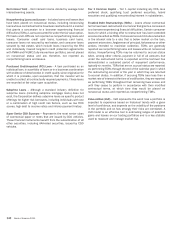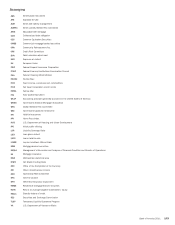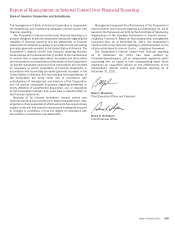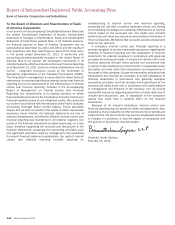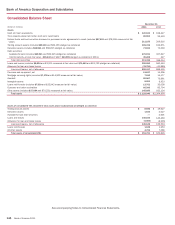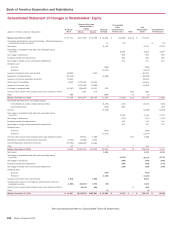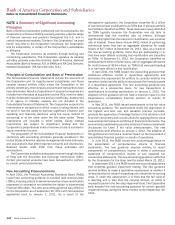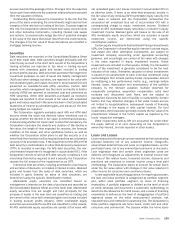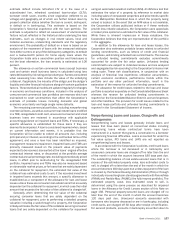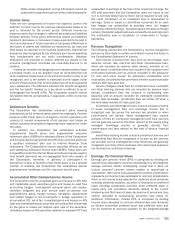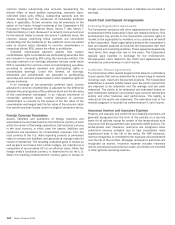Bank of America 2011 Annual Report Download - page 154
Download and view the complete annual report
Please find page 154 of the 2011 Bank of America annual report below. You can navigate through the pages in the report by either clicking on the pages listed below, or by using the keyword search tool below to find specific information within the annual report.152 Bank of America 2011
Bank of America Corporation and Subsidiaries
Notes to Consolidated Financial Statements
NOTE 1 Summary of Significant Accounting
Principles
Bank of America Corporation (collectively with its subsidiaries, the
Corporation), a financial holding company, provides a diverse range
of financial services and products throughout the U.S. and in
certain international markets. The term “the Corporation” as used
herein may refer to the Corporation individually, the Corporation
and its subsidiaries, or certain of the Corporation’s subsidiaries
or affiliates.
The Corporation conducts its activities through banking and
nonbanking subsidiaries. The Corporation operates its banking
activities primarily under two charters: Bank of America, National
Association (Bank of America, N.A. or BANA) and FIA Card Services,
National Association (FIA Card Services, N.A.).
Principles of Consolidation and Basis of Presentation
The Consolidated Financial Statements include the accounts of
the Corporation and its majority-owned subsidiaries, and those
variable interest entities (VIEs) where the Corporation is the
primary beneficiary. Intercompany accounts and transactions have
been eliminated. Results of operations of acquired companies are
included from the dates of acquisition and for VIEs, from the dates
that the Corporation became the primary beneficiary. Assets held
in an agency or fiduciary capacity are not included in the
Consolidated Financial Statements. The Corporation accounts for
investments in companies for which it owns a voting interest and
for which it has the ability to exercise significant influence over
operating and financing decisions using the equity method of
accounting or at fair value under the fair value option. These
investments are included in other assets. Equity method
investments are subject to impairment testing and the
Corporation’s proportionate share of income or loss is included in
equity investment income.
The preparation of the Consolidated Financial Statements in
conformity with accounting principles generally accepted in the
United States of America requires management to make estimates
and assumptions that affect reported amounts and disclosures.
Realized results could differ from those estimates and
assumptions.
The Corporation evaluates subsequent events through the date
of filing with the Securities and Exchange Commission (SEC).
Certain prior period amounts have been reclassified to conform
to current period presentation.
New Accounting Pronouncements
In April 2011, the Financial Accounting Standards Board (FASB)
issued new accounting guidance on troubled debt restructurings
(TDRs), including criteria to determine whether a loan modification
represents a concession and whether the debtor is experiencing
financial difficulties. This new accounting guidance was effective
for the Corporation as of September 30, 2011 with retrospective
application back to January 1, 2011. As a result of the
retrospective application, the Corporation classified $1.1 billion
of commercial loan modifications as TDRs that in previous periods
had not been classified as TDRs. These loans were newly identified
as TDRs typically because the Corporation was not able to
demonstrate that the modified rate of interest, although
significantly higher than the rate prior to modification, was a market
rate of interest. These loans include $402 million of performing
commercial loans that had an aggregate allowance for credit
losses of $27 million at December 31, 2011. Also, as a result of
the new accounting guidance, loans that are participating in or
that have been offered a binding trial modification are classified
as TDRs. At December 31, 2011, the Corporation classified an
additional $2.6 billion of home loans, with an aggregate allowance
for credit losses of $154 million, as TDRs that were participating
in or had been offered a trial modification.
In April 2011, the FASB issued new accounting guidance that
addresses effective control in repurchase agreements and
eliminates the requirement for entities to consider whether the
transferor/seller has the ability to repurchase the financial assets
in a repurchase agreement. This new accounting guidance was
effective, on a prospective basis, for new transactions or
modifications to existing transactions on January 1, 2012. The
adoption of this guidance will not have a material impact on the
Corporation’s consolidated financial position or results of
operations.
In May 2011, the FASB issued amendments to the fair value
accounting guidance. The amendments clarify the application of
the highest and best use, and valuation premise concepts,
preclude the application of blockage factors in the valuation of all
financial instruments and include criteria for applying the fair value
measurement principles to portfolios of financial instruments. The
amendments additionally prescribe enhanced financial statement
disclosures for Level 3 fair value measurements. The new
amendments were effective on January 1, 2012. The adoption of
this guidance will not have a material impact on the Corporation’s
consolidated financial position or results of operations.
In June 2011, the FASB issued new accounting guidance on
the presentation of comprehensive income in financial
statements. The new guidance requires entities to report
components of comprehensive income in either a continuous
statement of comprehensive income or two separate but
consecutive statements. This new accounting guidance is effective
for the Corporation for the three months ended March 31, 2012.
In September 2011, the FASB issued new accounting guidance
that simplifies goodwill impairment testing. The new guidance
permits entities to make a qualitative assessment of whether it
is likely that the fair value of a reporting unit is less than its carrying
value. If, under this assessment, it is likely that the fair value of
a reporting unit is less than the carrying amount, an entity is
required to perform the two-step impairment test. The Corporation
early adopted the new accounting guidance for certain goodwill
impairment tests during the three months ended September 30,
2011.


